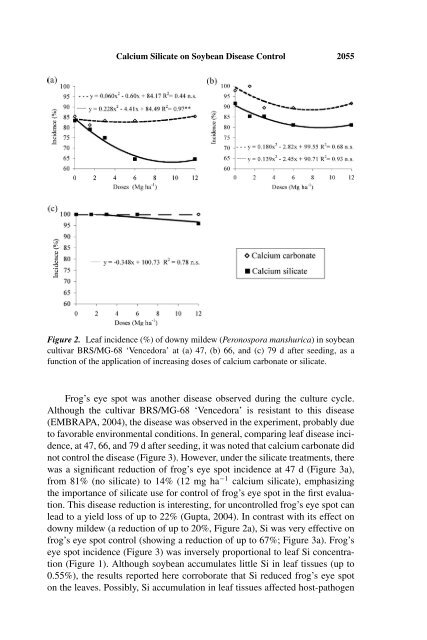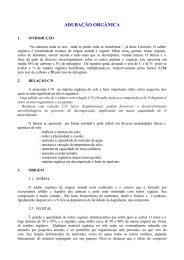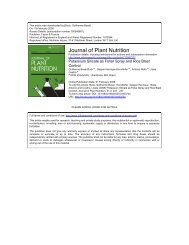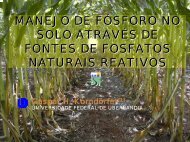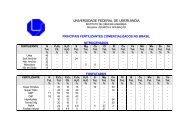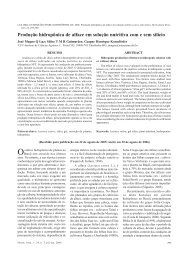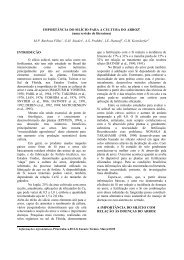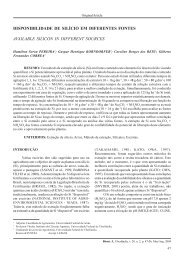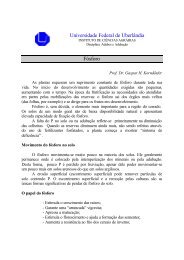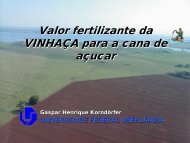2054 A. Nolla et al.calcium silicate <strong>in</strong>creased leaf Si concentration up to 1.70 fold, vary<strong>in</strong>g from0.34% to 0.55% if silicate was applied at doses <strong>of</strong> 0 or 12 mg ha −1 (Figure 1).These values were higher than those reported by Grothge-Lima et al. (1998)(0.02%–0.45%) after the application <strong>of</strong> 0 or 100 mg Si kg −1 (Si metasilicate—Na 2 SiO 3·5H 2 O) <strong>in</strong> nutrient solution. These differences could be expla<strong>in</strong>ed bythe sampl<strong>in</strong>g method adopted <strong>in</strong> each study. Here, the third leaf pair at flower<strong>in</strong>gstage (stage R 1 ), was sampled, whereas Grothge-Lima et al. (1998), sampledstem <strong>and</strong> leaves at stage V 1 . Therefore, a longer growth period was allowed, <strong>and</strong>the plant tissues analyzed could expla<strong>in</strong> the different Si contents between thetwo studies. Also, the <strong>in</strong>crease <strong>in</strong> Si content under the treatments where silicatewas applied was significant because the soil (Ustoxic Quartzipsamment) studiedhad low natural availability <strong>of</strong> Si (0.6 mg dm −3 ).The <strong>in</strong>crease <strong>in</strong> leaf Si concentration <strong>in</strong> soybean under the treatments wheresilicate was applied is desirable, as supply<strong>in</strong>g silicate has been shown to contributeto reduction <strong>of</strong> Fusarium solani (soybean sudden-death syndrome) <strong>and</strong>stem canker <strong>in</strong> soybean plants (Juliatti et al., 2003). In cucumber, Si acts <strong>in</strong> thehost tissue, affect<strong>in</strong>g signal<strong>in</strong>g between host <strong>and</strong> pathogen, which results <strong>in</strong> afaster <strong>and</strong> more extensive activation <strong>of</strong> plant defense mechanisms, probably asa function <strong>of</strong> phytoalex<strong>in</strong> production (Samuels et al., 1991; Chérif et al., 1994).The observation <strong>of</strong> downy mildew <strong>in</strong>cidence on soybean leaves at 47, 66,or 79 d after seed<strong>in</strong>g <strong>in</strong>dicated that the disease was not controlled <strong>in</strong> the calciumcarbonate plots (Figure 2). However, there was a reduction <strong>of</strong> downy mildew <strong>in</strong>cidenceunder the silicate treatments, especially at 47 d after seed<strong>in</strong>g (Figure 2a),from 85% (no silicate) to 65% (12 mg ha −1 calcium silicate), demonstrat<strong>in</strong>g theefficacy <strong>of</strong> Si <strong>in</strong> disease control <strong>in</strong> the first evaluation. This reduction probablyoccurred as a function <strong>of</strong> greater Si accumulation <strong>in</strong> soybean leaf tissue underthe silicate treatments (Figure 1). It is expected that, <strong>in</strong> cropp<strong>in</strong>g areas, thisreduction <strong>in</strong> disease <strong>in</strong>cidence after soil <strong>in</strong>corporation <strong>of</strong> calcium silicate couldalso result <strong>in</strong> a reduction <strong>in</strong> use <strong>of</strong> fungicide sprays, as well as lead to a greateryield due to the longer ma<strong>in</strong>tenance <strong>of</strong> photosynthesiz<strong>in</strong>g area.There was no difference <strong>in</strong> downy mildew <strong>in</strong>cidence 66 d after seed<strong>in</strong>g(Figure 2b); however, where calcium carbonate was applied, there was a trend<strong>of</strong> greater <strong>in</strong>cidence (90%–100%) than where silicate was applied (81%–92%).This result demonstrates, once aga<strong>in</strong>, that the application <strong>of</strong> calcium silicate wasmore effective for disease control, possibly due to the activation <strong>of</strong> biochemicalmechanisms <strong>of</strong> plant defense (Korndörfer et al., 2004). In the last evaluation(Figure 2c), 79 d after seed<strong>in</strong>g, downy mildew <strong>in</strong>cidence was 100% under thelim<strong>in</strong>g treatment. Similarly, under the silicate treatments, disease <strong>in</strong>cidence wasnear 100%, vary<strong>in</strong>g from 96% to 100%. Accord<strong>in</strong>g to Korndörfer et al. (2004),the <strong>in</strong>corporation <strong>of</strong> silicate <strong>in</strong>to the soil does not prevent disease <strong>in</strong>cidence;however, as observed here, it can delay disease onset <strong>and</strong> reduce its <strong>in</strong>cidenceearly <strong>in</strong> the growth season. This action is highly desirable, especially consider<strong>in</strong>gthat disease control with fungicides can be delayed, <strong>and</strong> the number <strong>of</strong>sprays reduced, thus reduc<strong>in</strong>g production costs.
<strong>Calcium</strong> <strong>Silicate</strong> on <strong>Soybean</strong> <strong>Disease</strong> Control 2055Figure 2. Leaf <strong>in</strong>cidence (%) <strong>of</strong> downy mildew (Peronospora manshurica)<strong>in</strong>soybeancultivar BRS/MG-68 ‘Vencedora’ at (a) 47, (b) 66, <strong>and</strong> (c) 79 d after seed<strong>in</strong>g, as afunction <strong>of</strong> the application <strong>of</strong> <strong>in</strong>creas<strong>in</strong>g doses <strong>of</strong> calcium carbonate or silicate.Frog’s eye spot was another disease observed dur<strong>in</strong>g the culture cycle.Although the cultivar BRS/MG-68 ‘Vencedora’ is resistant to this disease(EMBRAPA, 2004), the disease was observed <strong>in</strong> the experiment, probably dueto favorable environmental conditions. In general, compar<strong>in</strong>g leaf disease <strong>in</strong>cidence,at 47, 66, <strong>and</strong> 79 d after seed<strong>in</strong>g, it was noted that calcium carbonate didnot control the disease (Figure 3). However, under the silicate treatments, therewas asignificant reduction <strong>of</strong> frog’s eye spot <strong>in</strong>cidence at 47 d (Figure 3a),from 81% (no silicate) to 14% (12 mg ha −1 calcium silicate), emphasiz<strong>in</strong>gthe importance <strong>of</strong> silicate use for control <strong>of</strong> frog’s eye spot <strong>in</strong> the first evaluation.This disease reduction is <strong>in</strong>terest<strong>in</strong>g, for uncontrolled frog’s eye spot canlead to a yield loss <strong>of</strong> up to 22% (Gupta, 2004). In contrast with its effect ondowny mildew (a reduction <strong>of</strong> up to 20%, Figure 2a), Si was very effective onfrog’s eye spot control (show<strong>in</strong>g a reduction <strong>of</strong> up to 67%; Figure 3a). Frog’seye spot <strong>in</strong>cidence (Figure 3) was <strong>in</strong>versely proportional to leaf Si concentration(Figure 1). Although soybean accumulates little Si <strong>in</strong> leaf tissues (up to0.55%), the results reported here corroborate that Si reduced frog’s eye spoton the leaves. Possibly, Si accumulation <strong>in</strong> leaf tissues affected host-pathogen


